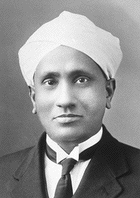Chandrasekhara Venkata Raman
|
|
Chandrasekhara Venkata Raman (November 7, 1888-November 21, 1970) was an Indian physicist, who was awarded the 1930 Nobel Prize in Physics for his work on the scattering of light and for the discovery of the effect named after him.
Raman was born in Tiruchirapalli, Tamil Nadu. At an early age Raman moved to the city of Visakhapatnam, Andhra Pradesh. He completed his BA and MA in Physics and English from the Presidency College, Madras (now Chennai). He entered Presidency College, Madras, in 1902, and in 1904 passed his B.A. examination, winning the first place and the gold medal in physics; in 1907 he gained his M.A. degree, obtaining the highest distinctions. He joined the Indian Civil Services as an Assistant Accountant General in Calcutta (now Kolkata).
Raman was a professor of Physics at the Calcutta University for the next fifteen years. It was here that his work on optics got recognized.
Raman won the 1930 Nobel Prize in Physics for his work on the scattering of light and for the discovery of the Raman effect. Raman spectroscopy, based on his effect is also named after him. It was the first time that an Indian scholar who studied wholly in India received the Nobel Prize. An interesting anecdote goes that he was offered a toast during the Nobel function. Being a strict teetotaller he responded, "Sir! You have seen the Raman effect on alcohol! Please do not try to see the alcohol effect on Raman."
In 1934, Raman became the director of the newly established Indian Institute of Science in Bangalore, where two years later he continued as a professor of physics. In 1947, he was appointed as the first National Professor by the new government of Independent India. He retired from the Indian Institute in 1948 and a year later he established the Raman Research Institute in Bangalore, serving as its director and remained active there until his death on November 21, 1970, at the age of eighty two.
He was knighted in 1929 and awarded the Bharat Ratna in 1954.
CV Raman is the uncle of Nobel Prize Physics winner Dr. Subrahmanyan Chandrasekhar.
India celebrates National Science Day on the 28th February of every year. It is on this day that Dr.CV Raman discovered Raman effect in 1928.
Work
- "Dynamical Theory of the Motion of Bowed Strings", Bulletin, Indian Association for the Advancement of Science, 1914
- "On the molecular scattering of light in water and the colour of the sea", Proceedings of the Royal Society, 1922
- "A new type of Secondary Radiation", Nature, 1928
- "A new radiation", Indian Journal of Physics, 1928
- Aspects of Science, 1948
- The New Physics: Talks on Aspects of Science, 1951
- Lectures on Physical Optics, 1959
External links
- Britannica on Raman (http://www.britannica.com/nobel/micro/493_32.html)
- Nobel prize internet archive (http://almaz.com/nobel/physics/1930a.html)
- Nobel Lecture (http://nobelprize.org/physics/laureates/1930/raman-lecture.pdf)de:Chandrasekhara Venkata Raman
es:Chandrasekhara Raman fr:Chandrashekhara Venkata Râman hi:सी वी रामण id:Venkata Raman kn:ಚಂದ್ರಶೇಖರ ವೆಂಕಟ ರಾಮನ್ nl:Chandrasekhara Venkata Raman pl:Chandrasekhara Venkata Raman sa:चन्द्रशेखर वेङ्कट रामन् sv:C.V. Raman ta:சந்திரசேகர வெங்கட ராமன்

